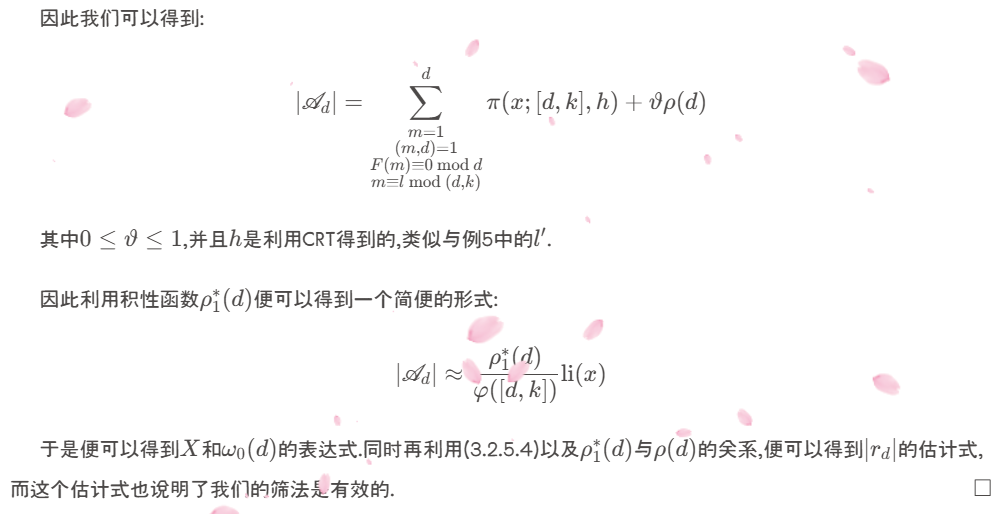超纲亿点但是非常有趣的小题! -- 为什么所有孪生素数的倒数之和是收敛的?
引言
如果现在问,有哪些是你看得懂,但是目前仍未解决的数学猜想,那我想大概率会有孪生素数猜想的一个位置.2025年的第一篇有趣的小题,我们整个小活.🥰
孪生素数猜想:
存在无穷多组2-prime tuples ;即存在无穷多个素数 ,使得 也是素数.
而目前对孪生素数的大部分结论,都是用筛法以及圆法做出来的,目前最优的结果有:
三素数定理(圆法):
每个大于等于9的奇数都可以表示为三个奇素数之和.
以及张益唐等人的工作:
素数间隙定理(筛法):
存在无穷多个素数 ,使得在 中至少还有一个素数.若用 表示第 个素数,也就是有
但是这些定理有一点点超纲啊,那么有没有一些学了高数就能解决的定理呢?
欸!有的同学,有的!这样的定理足足有两个!当然得先承认一些小小的事实,但这些也只需一些简单的筛法知识即可,但是简单不等于好讲,这涉及到很多同余式的计算,式子稍微有亿点点丑.例如:

于是,我们将在承认两个事实的基础下,证明下面两个定理:
1. Merten定理
所有素数的倒数之和是发散的. 2. Brun推论
所有孪生素数的倒数之和是收敛的.
如果知道以下知识可能更容易理解: 级数
适合人群: 对数论感兴趣就能看懂(吧)
后续我们也会不定时推送有趣的小题系列,并且更偏向于数学学习过程中涉及到的概念和知识点的巩固与深入,感兴趣的同学可以多多关注!
承认环节
后续文中出现的
素数计数函数
首先,我们承认素数定理,并且利用其的一个较弱的估计式(注意右侧是小
其中
而(2.1)的意思是,不超过
或者是:
例如
如同高数上所说的等价无穷小一样,我们可以认为(2.1.1)是一个"等价无穷大",更数学语言一点的,这其实是一个渐近式.
孪生素数对计数函数
其次就是承认关于孪生素数对计数函数
其中
于是知道的是:
而(2.2)的意思是,不超过
而当
实际上,上述两个都有更加精细的估计,但在此按下不表.
现在万事俱备,准备开始work work!
Merten定理
现在我们开始证明Merten定理
Merten定理:
换言之,所有的素数的倒数之和是发散的.
证明:
因此我们便证明了所有素数的倒数之和是发散的.最后我们用一个表格来统计陶哲轩用了也说好👍).
| n的取值 | 实际个数 | 估计个数 | 误差 |
|---|---|---|---|
|
|
|
|
|
|
|
|
|
|
|
|
|
|
|
|
|
|
|
|
|
|
|
|
|
|
|
|
|
|
|
|
|
|
|
|
|
|
|
|
因此我们可以看到,即使是直接使用(3.2),我们也能够证明我们想要的结论.
实际上,Merten定理有一个更有确定的形式,也就是:
也就是说,不超过
Brun定理
接下来就是本篇文章的重点内容,而Brun定理实际上就是(2.2)所述,但我们这里证明的是其推论:
Brun推论:
而这便能推出所有孪生素数的倒数之和是收敛的.
而这里又有一个Brun常数,其定义为所有孪生素数的倒数之和:
而我们这里只证明在承认(2.2)的前提下,有
证明:
实际上,对于孪生素数对的个数有一个更加精细的估计,那就是:
但是目前关于
其中:
而根据OEIS的数据
| n的取值 | 实际个数 | 估计个数 | 相差倍数 | 猜测个数 |
|---|---|---|---|---|
|
|
|
|
|
|
|
|
|
|
|
|
|
|
|
|
|
|
|
|
|
|
|
|
|
|
|
|
|
|
|
|
|
|
|
|
|
|
|
|
|
|
|
|
|
|
|
|
因此我们的证明过程是可行的,并且Hardy-Littlewood猜想正确的置信度很高.
重新理解计数函数的估计式
最后我们来从直观角度来理解计数函数的估计式(才不是因为证明太复杂了😎).
首先就是素数定理(2.1):
而这个渐近估计式是Legendre发现的,而更精确一点的渐近估计式是Gauss猜测的:
用分部积分公式就可以知道Gauss猜测的式子和Legendre是一样的.而我们通过图像就可以观察到这种估计式的合理性,因此我们只需要亿点点的注意力,应该也能做出Gauss一样的猜测,再不济和Legendre一样的猜测也是不难的.

于是我们便可以说,在
如果!素数的分布是独立的话!那么在
于是在
但是很显然,素数的分布并不是那么独立,但是如果关联不是很大的话,那我们可以期待的是,孪生素数对的个数与上面的猜测值之间相差不大(也就是相差一个常数).于是我们便很自然的猜测有(4.4)成立,于是为我们的研究指明了一个方向,而这个被证明确实是对的.
我们也可以很自然的,利用(4.4)来证明出所有孪生素数的倒数之和是收敛的,方法也可以用上面的放缩同样的得到.
但是,注意到用我们的方法证明Brun推论并不需要用到(4.4)那么强的估计,只需要有:
于是,Brun就利用筛法得到(2.2),进而得到了
思考题Never Gonna Give You Up!!!
好吧,没有思考题,说有思考题但是又没有这未尝不是一种诈骗呢.但是,欢迎大家提供思考题或者是有趣小题,有趣的题在这个世界上到处都有,或许下一个选上的就是你呢?

以上内容是我学习筛法过程中,发现在付出巨大的贡献,巨大的牺牲,巨大的Carry得到(2.1)和(2.2)后,剩下的东西完全可以用高数中级数的东西来解释,因此催生出这篇文章,或者说这又是我的一次个人学习记录.😋
在LessWrong网站上,Ege Erdil的文章虽然可能有亿点点超纲)
然后就是直接复制一下原文的Conclusion,也相当于是贴一下Abstract一样:
The fundamental nature of the above proof is that we understand the behavior of primes relative to modular congruence classes quite well, at least when the modulus is small compared to the primes in question. We then try to leverage our understanding here into saying something about the distribution of primes in other sets.
This is the heart of sieve theory: it's used in cases when you understand the behavior of some objects well in some substructures and you want to "piece that together" to gain a broader understanding of how the objects behave. Here, the substructures are arithmetic progressions or modular congruence classes, and the objects are the prime numbers, but the fundamental ideas of sieve theory may be applied in other domains as well.
The Brun sieve itself is a fairly basic sieve that was introduced over a hundred years ago for the exact purpose of proving tight upper bounds on
, though it can also be used for other purposes as a general way to prove upper bounds on various quantities involving primes using combinatorial methods. Today, more sophisticated sieves are able to prove nontrivial lower bounds as well, which is often a more tricky problem than proving upper bounds in sieve theory. For more on sieve theory, you might want to check out the associated tag on Terence Tao's blog. It contains material ranging from introductory to research-level in sophistication.
参考资料
[1] Halberstam, Richert. Sieve Methods[M]. Dover Publications, 2011. P37-P52.
[2] 潘承洞, 潘承彪. 解析数论基础[M]. 哈尔滨工业大学出版社, 2016. P17-P19.
[3] Ege Erdil. Brun's theorem and sieve theory[Z]. https://www.lesswrong.com/posts/aSYvbztFDdG7LBeRz/brun-s-theorem-and-sieve-theory#The_sieve_of_Eratosthenes.
[4] 关于素数指标求和的估计. Chatgpt[Z]. https://chatgpt.com/share/67b01f77-4234-800c-9b15-158446dbb868.
[5] Mathematics. Stackexchange. Prove that
[6] Wikipedia. Merten's theorem[Z]. https://en.wikipedia.org/wiki/Mertens%27_theorems.
[7] OEIS. Number of primes < 10^n[Z]. https://oeis.org/A006880.
[8] OEIS. Number of twin prime pairs below 10^n[Z]. https://oeis.org/A007508.
[9] Wikipedia. Twin prime[Z]. http://en.wikipedia.org/wiki/Twin_prime.
[10] Wikipedia. Chebyshev function[Z]. https://en.wikipedia.org/wiki/Chebyshev_function.
[11] Wikipedia. Brun's theorem[Z]. https://en.wikipedia.org/wiki/Brun%27s_theorem.